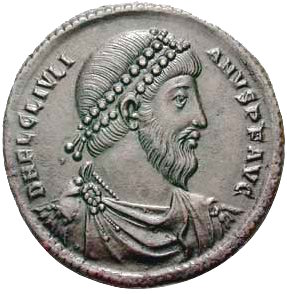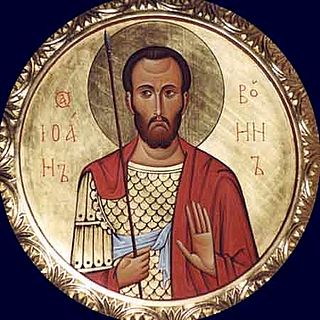Julian the Hermit of Mesopotamia adopted the ascetic life during the reign of Roman emperor Julian the Apostate in the fourth century AD. Saint Julian dwelt in solitude near the river Euphrates.
In his solitude, Julian heard from God that the apostate emperor would soon die. The emperor's death quickly came to pass as the Lord had revealed to Julian.
Through the efforts of St. Julian, a church was built on Mount Sinai in memory of the obtaining of the tablets of the Law by the holy Prophet Moses on the spot where Moses was standing when he received the tablets.
Venerable Julian the Hermit of Mesopotamia is commemorated on 18 October in the Eastern Orthodox, Byzantine Catholic, and Roman Catholic [1] Churches.
The 360s decade ran from January 1, 360, to December 31, 369.
The 330s decade ran from January 1, 330, to December 31, 339.

Year 361 (CCCLXI) was a common year starting on Monday of the Julian calendar. At the time, it was known as the Year of the Consulship of Taurus and Florentius. The denomination 361 for this year has been used since the early medieval period, when the Anno Domini calendar era became the prevalent method in Europe for naming years.

Saint Jacob of Nisibis, also known as Saint Jacob of Mygdonia, Saint Jacob the Great, and Saint James of Nisibis, was a hermit, a grazer and the Bishop of Nisibis until his death.

Oct. 31 - Eastern Orthodox liturgical calendar - Nov. 2

A recluse is a person who lives in voluntary seclusion and solitude. The word is from the Latin recludere, which means "shut up" or "sequester". Unlike common hermits, recluses shut themselves up in a cell so that they could not come out.

Sergiusand Bacchus were fourth-century Syrian Christian soldiers revered as martyrs and military saints by the Catholic, Eastern Orthodox and Oriental Orthodox Churches. Their feast day is 7 October.

October 17 - Eastern Orthodox liturgical calendar - October 19

January 12 - Eastern Orthodox liturgical calendar - January 14

February 13 - Eastern Orthodox liturgical calendar - February 15

Eastern Christian monasticism is the life followed by monks and nuns of the Eastern Orthodox Church, Oriental Orthodoxy, the Church of the East and some Eastern Catholic Churches.

Anthony the Hermit, also known as Anthony of Lérins, is a Christian who is venerated as a saint. He was born in the ancient Roman province of Pannonia Valeria, then part of the Hunnic Empire. When he was eight years old, his father died and he was entrusted to the care of the abbot Severinus of Noricum, in modern-day Austria. Upon the death of Severinus in 482, Anthony was sent to Germany and put in the care of his uncle, Constantius, an early Bishop of Lorsch. While there, Anthony is thought to have become a monk at the age of twenty.

Joannicius the Great was a Byzantine Christian saint, sage, theologian and prophet. Well known for his devoted asceticism and defense of icon veneration, Joannicius spent the majority of his life as a hermit on Mysian Olympus, near what is today Bursa, Turkey. Joannicius lived during the reign of Emperor Theophilos, a noted iconoclast, which contrasted with Joannicius's embrace of icon veneration. Icon veneration was later restored to the Byzantine Empire under the reign of Empress Theodora, a move that some devotees ascribe to Joannicius's influence and prophecies. Joannicius served in the Byzantine army in his early years before devoting his life to ascetic study and monastic contemplation. He is venerated with a feast day on November 4 in the Eastern Orthodox Church and Roman Catholic Church.

Christianity in late antiquity traces Christianity during the Christian Roman Empire — the period from the rise of Christianity under Emperor Constantine, until the fall of the Western Roman Empire. The end-date of this period varies because the transition to the sub-Roman period occurred gradually and at different times in different areas. One may generally date late ancient Christianity as lasting to the late 6th century and the re-conquests under Justinian of the Byzantine Empire, though a more traditional end-date is 476, the year in which Odoacer deposed Romulus Augustus, traditionally considered the last western emperor.

Chariton the Confessor was an early Christian monk. He is venerated as a saint by both the Western and Eastern Churches. His remembrance day is September 28.

Mercurius was a Roman soldier of Scythian descent who became a Christian saint and martyr. He was born in the city of Eskentos in Cappadocia, in Eastern Asia Minor. According to Christian tradition, he was the soldier who killed Julian the apostate during his campaign in Persia. Saint Mercurius was also widely known by his Arabic-language name Abu-Sayfain, Abu-Sifin or Abu-Sefein in Egyptian Arabic which means "father of two swords", referring to the second sword given to him by the Archangel Michael.
The restoration of paganism from Julian until Valens was a brief period, from 361 until 375, of relative tolerance towards pagans in the Roman Empire. In the late Roman Empire, it was preceded by a period of persecutions under Emperor Constantius II and was followed by those of Emperor Gratian. The attempt of Emperor Julian the Apostate to restore pagan worship in the empire, while ultimately a policy failure, restored security to pagans. His immediate successors, under the reigns of Jovian, Valens and Valentinian I, had a policy of relative religious toleration towards paganism.

John the Warrior or John the Soldier in the Catholic Church is a Christian saint and martyr. He was born in the 4th century and lived until his death in the Byzantine Empire. Forced by Julian the Apostate to serve as a warrior against Christianity, he was imprisoned after being caught helping people in need or defending Christians, and awaited there his death penalty. However, John the Warrior was released after the death of the emperor during a war.

December 4 - Eastern Orthodox liturgical calendar - December 6
Saint Julian Sabas was a hermit who spent most of his life in deserted parts of Syria, but left his cell for a short period to denounce Arianism. His feast day is 14 January or 18 October in the Roman Church.